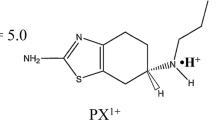Abstract
The effects of penetrant properties (lipophilicity and charge) and of vehicle pH on the iontophoretically enhanced delivery of amino acids and their N-acetylated derivatives have been examined in vitro. The penetrants were nine amino acids (five were zwitterionic, two positively charged, and two negatively charged) and four N-acetylated amino acids, which carry a net negative charge at pH 7.4. Iontophoresis at constant current (0.36 mA/cm2), using Ag/AgCl electrodes, was conducted across freshly excised hairless mouse skin. Iontophoretic flux of the zwitterions was significantly greater than passive transport. Delivery from the anode was greater than from the cathode for all zwitterions. The level of enhancement was inversely proportional to permeant octanol/pH 7.4 buffer distribution coefficient. Cathodal iontophoresis of the negatively charged amino acids and of the N-acetylated derivatives produced degrees of enhancement which were significantly greater than those measured for the “neutral” zwitterions. Furthermore, the enhanced flux reached a steady-state level within a few hours for the negatively charged species, whereas the transport of the zwitterions continued to increase with time. Anodal iontophoresis of histidine and lysine, the two positively charged amino acids studied, induced substantial enhancement which was sensitive to the pH of the delivery vehicle. For example, the flux of histidine from an applied solution at pH 4 (where the amino acid carries a net positive charge) was significantly greater than that from a vehicle at pH 7.4 (where histidine is essentially neutral). The behavior of lysine was more complex and suggested a certain degree of neutralization of the skin's net negative charge.
Similar content being viewed by others
REFERENCES
P. Tyle. Iontophoretic devices for drug delivery. Pharm. Res. 3:318–326 (1986).
R. R. Burnette. Iontophoresis. In J. Hadgraft and R. H. Guy (eds.), Transdermal Drug Delivery. Developmental Issues and Research Initiatives, Marcel Dekker, New York, 1989, pp. 247–291.
R. R. Burnette and B. Ongpipattanakul. Characterization of the permselective properties of excised human skin during iontophoresis. J. Pharm. Sci. 76:765–773 (1987).
R. R. Burnette and D. Marrero. Comparison between the iontophoretic and passive transport of thyrotropin. J. Pharm. Sci. 75:738–743 (1986).
L. P. Gangarosa, N. H. Park, C. A. Wiggins, and J. M. Hill. Increased penetration of nonelectrolytes into mouse skin during iontophoretic water transport (iontohydrokinesis). J. Pharm. Exp. Ther. 212:377–381 (1980).
P. G. Green, R. S. Hinz, A. Kim, F. Szoka, and R. H. Guy. Iontophoretic delivery of a series of tripeptides across the skin in vitro. Pharm. Res. 8:1121–1127 (1991).
A. Kim and F. Szoka. The distribution of tripeptides between octanol and water (submitted for publication).
P. Glikfeld, C. Cullander, R. S. Hinz, and R. H. Guy. A new system for in vitro studies of iontophoresis. Pharm. Res. 5:443–446 (1988).
D. R. Crow. Principles and Applications of Electrochemistry, 2nd ed., Chapman and Hall, London, 1979.
R. C. Thomas, Ion-Selective Intracellular Microelectrodes: How to Make and Use Them, Academic Press, London, 1978.
L. M. Yunger and R. D. Cramer. Measurement and correlation of partition coefficients of polar amino acids. Mol. Pharmacol. 20:602–608 (1981).
J. L. Fauchere and V. Pliska. Hydrophobic parameters P of amino-acid side chains from the partitioning of N-acetyl-amino-acid amides. Eur. J. Med. Chem. Chim. Ther. 18:369–375 (1983).
Handbook of Chemistry and Physics, 66th ed., CRC Press, Boca Raton, Fla., 1985.
G. Kortüm, W. Vogel, and K. Andrusson. I.U.P.A.C. Dissociation Constants of Acids in Aqueous Solution, Butterworth, London, 1961.
S. Del Terzo, C. R. Behl, and A. R. Nash. Iontophoretic transport of a homologous series of ionized and nonionized model compounds: Influence of hydrophobicity and mechanistic interpretation. Pharm. Res. 6:85–90 (1989).
M. J. Pikal and S. Shah. Transport mechanisms in iontophoresis. II. Electroosmotic flow and transference number measurements for hairless mouse skin. Pharm. Res. 7:213–221 (1990).
J. B. Phipps, J. M. Sunram, and R. V. Padmanabhan. The effect of extraneous ions on the transdermal iontophoretic delivery of hydromorphone. Proc. Int. Symp. Control. Rel. Bioact. Mater. 16:50–51 (1989).
B. W. Barry. Dermatological Formulations—Percutaneous Absorption, Marcel Dekker, New York, 1983, p. 236.
M. J. Pikal and S. Shah. Transport mechanisms in iontophoresis. III. An experimental study of the contributions of electroosmotic flow and permeability change in the transport of low and high molecular weight solutes. Pharm. Res. 7:222–229 (1990).
L. L. Wearley, K. Tojo, and Y. W. Chien. A numerical approach to study the effect of binding on the iontophoretic rate of transport of a series of amino acids. J. Pharm. Sci. 79:992–998 (1990).
R. S. Hinz, C. D. Hodson, C. R. Lorence, and R. H. Guy. In vitro percutaneous penetration: Evaluation of the utility of hairless mouse skin. J. Invest. Dermatol. 93:87–92 (1989).
M. J. Pikal. Transport mechanisms in iontophoresis. I. A theoretical model for the effect of electroosmotic flow on flux enhancement in transdermal iontophoresis. Pharm. Res. 7:118–126 (1990).
Author information
Authors and Affiliations
Rights and permissions
About this article
Cite this article
Green, P.G., Hinz, R.S., Cullander, C. et al. lontophoretic Delivery of Amino Acids and Amino Acid Derivatives Across the Skin in Vitro . Pharm Res 8, 1113–1120 (1991). https://doi.org/10.1023/A:1015894016235
Issue Date:
DOI: https://doi.org/10.1023/A:1015894016235



